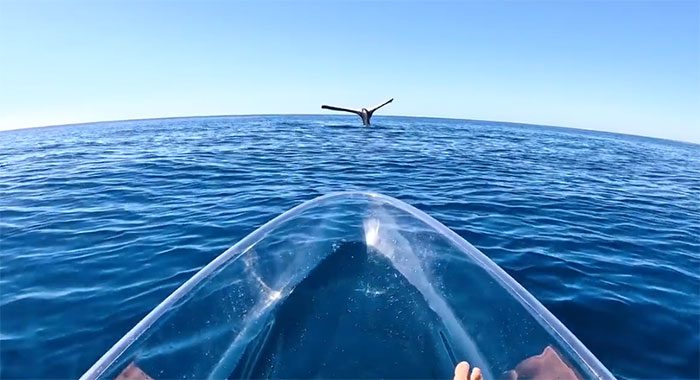While paddling in a transparent kayak, Brodie Moss, a popular TikToker, suddenly spotted a whale’s tail standing upright in the ocean before him.
A humpback whale mother is upside down in a vertical position underwater. (Video: Brodie Moss).
Moss shared a video capturing the scene of the upright whale tail on August 13 on his YouTube channel. In the video, the deeply grooved tail of the humpback whale (Megaptera novaeangliae) appears to float along the horizon, almost completely motionless, according to Science Alert.
As he paddled backward to maintain distance from the creature, Moss noticed a young whale swimming around the tail. He directed the camera underwater and discovered that the young whale was gently resting its head against the chest of the adult whale, likely its mother. The two whales seemed to communicate with each other through sounds resembling singing.
This unusual tail-up behavior not only astonished Moss and many viewers. Researchers have pondered over this behavior for decades. Since the whale’s tail resembles a sail when it rises above the ocean’s surface, this behavior is sometimes referred to as “tail sailing”. It is a very rare sight, witnessed only occasionally by those observing humpback whales, gray whales, bowhead whales, and smooth whales.

The unusual tail-up behavior amazes many viewers.
Moss did not disclose the filming location, but he is a member of the YBS Youngbloods team, which specializes in posting videos filmed along the coastal areas of Western Australia between Exmouth and Broome. A whale-watching company in Western Australia had previously recorded this special behavior of whales in 2019 and 2020. A long-term study of whales from 1989 to 2000 occasionally encountered tail-up behavior, with each instance lasting from a few seconds to 12 minutes. In most cases, experts in Brazil observed whales twisting their tails slowly, allowing them to rotate along a vertical axis.
This tail-up behavior has been documented in solitary whales, mother whales, and even pregnant whales. When a mother whale engages in such behavior, the calf often swims around, as was the case that Moss witnessed in Australia. A calf off the coast of Brazil even nursed while its mother held her tail upright. In 2016, a drone off Maui captured footage of a humpback whale’s tail upright on the water for over 10 minutes.
A whale researcher suggests that the tail-up behavior may be related to resting. Similar to how humpback whales sleep vertically in the water column, a mother whale might flip upside down in a tail-up position to rest while keeping an eye on her calf. This could also be a way to cool off. By exposing their tail to the wind, warm-blooded whales can regulate their body temperature. The whale’s tail contains many blood vessels, which can effectively absorb or release heat from the body. However, this remains a speculative hypothesis. Moss hopes that the footage will help scientists better understand this behavior.


















































